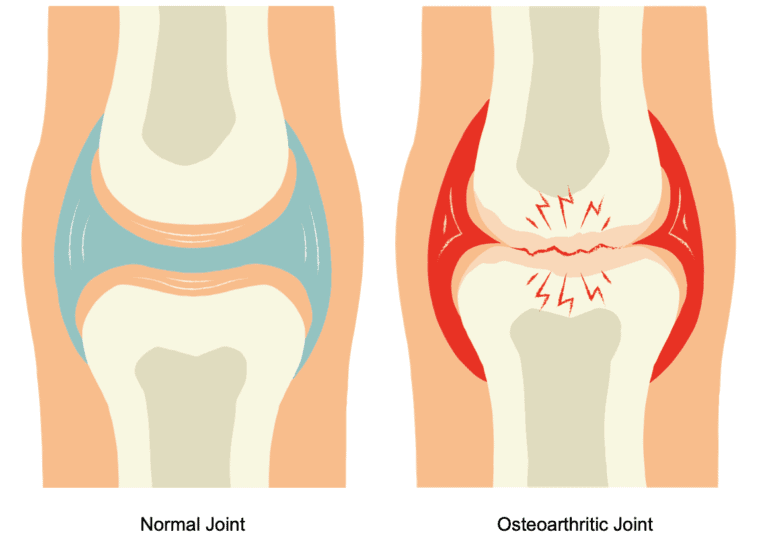Our dogs are more than just pets; they’re family members who bring joy and companionship into our lives. So when arthritis strikes, it affects both of us. Seeing them struggle to do things they once loved is a harsh reminder that our time with them is precious and fleeting.
Arthritis is a condition characterised by inflammation and stiffness in the joints.
The name Arthritis is derived from the Greek words Arthro = ‘Joint’, and ‘Itis’ = Inflammation
There are many different types of arthritis (over 100 variations in humans), but the most common in humans and animals is osteoarthritis (OA).
Both human and animal joints possess a remarkable design that allows for efficient movement and functionality. The two joint surfaces rubbing against each other inside of a joint are 5 times as slippery as ice on ice when not injured!
Osteoarthritis arises when the joint surfaces progressively erode away, resulting in an altered environment where the joints lose their smoothness and effective lubrication.
Every pet will experience arthritis differently. In some cases it will barely affect your pet at all, but in other cases it can create tremendous persistent pain which affects your pet’s ability to move, and ultimately, their quality of life.

Arthritis can set in due to a number of reasons.
Ageing – As pets age, they tend to develop arthritis. It’s not necessarily their age that causes the arthritis, but likely all the things that happen to them throughout their life.
Trauma – Trauma to a joint has the potential to progress to arthritis later in life. This can be both major traumas like fractures, dislocations, ligament ruptures, hit by cars etc, as well as repetitive micro traumas over a long period of time.
Obesity – Carrying extra weight puts more demand on joints and tends to speed up the arthritic process. I’d class this as a form of trauma to the joint.
Genetics – Can be passed down from one generation to the next.
Poorly Formed Joints – This can happen at any joint, but hip and elbow dysplasia tend to be the more recognised areas where this happens. When a joint isn’t formed properly, it moves unevenly causing repetitive trauma, which speeds up the arthritis process.
Surgery – Surgery is sometimes recommended for cases of arthritis where either;
1. The arthritis is so severe and the veterinarian thinks that pain and/or function will be improved with surgical intervention, or,
2: Without surgical intervention, the arthritis will continue to worsen and be a bigger problem down the track.
It’s important to know that surgery itself can cause arthritis – it’s a form of trauma, but in the two situations above it’s considered to be a better outcome than no intervention.
Idiopathic – This is a fancy medical term for ‘we have no idea’. For some dogs, unfortunately, arthritis just happens for no apparent reason.
Pets will experience the same symptoms that humans with arthritis get. If you’ve got arthritis, you’ll know very well what this feels like.
Pain – Can be sharp, dull, aching pain. Pain can be localised to the joint, or it can radiate to other nearby areas. Pets with arthritis in the spine may also experience nerve pain. The truth is we never know exactly what the pain feels like for a pet because they can’t verbalise their experience
Stiffness – Joints won’t move fluently. They may grind or click, with or without pain. The range of motion of the joint can be restricted.
Swelling – Not always obvious, but some pets’ joints will visibly swell when inflammation or bone remodelling sets in. In the case of inflammation, you may also notice some localised heat in the area.
Mood – When a dog is in pain and they can’t move like they want to they can get depressed, grumpy and not want to engage in activity.
Reduced Mobility – The combination of everything above means moving is more difficult, both physically and mentally.
Some pets will have only one of these symptoms that flare up from time to time, others will experience all of them constantly. Most dogs will sit in the middle of those two extremes. Cold weather, activity after periods of rest and after excessive exercise are times when you may find these things flaring up.
At the Animal Rehab Klinik we help pets with arthritis improve their quality of life using rehabilitation techniques that we’ve tried and tested on humans for decades.
Our team of qualified professionals understand that managing pain and encouraging movement is essential in helping your dog live their life to the fullest, regardless of whether it’s through physiotherapy, chiropractic, or osteopathy.
We not only provide treatment for your dog, but we also offer guidance on how to effectively manage your dog’s arthritis as they grow older.